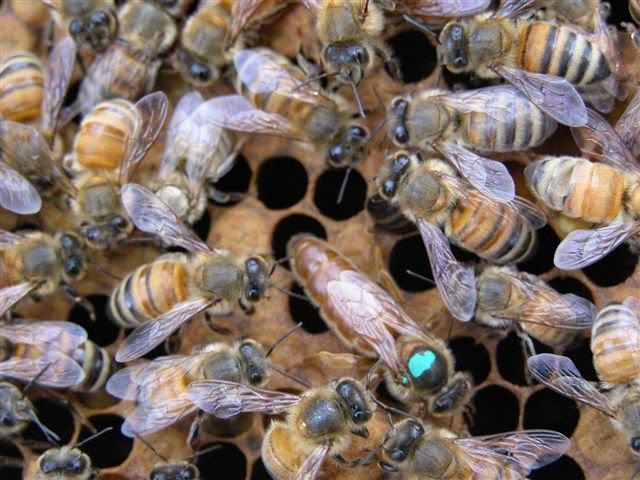|
|
Post by canadamike on Mar 1, 2009 18:28:57 GMT -5
This one is for everybody, but I would love Doc Kapuler to step in.
I am in a situation where I can help convert at least part of a dairy farm to non-gmo OP grains. I guess you all know I ambition more than
a partial transformation. I live in the county where milk production is the highest in the world.
When a local cow is up for sales she often end up crossing borders, most of the time for Wisconsin or Pennsylvania, but also often anywhere in the world.
They call that superior genetics. They have problems with calf laying but hey..... they pump out milk.
The proper feeding is said to be more important here because it helps express our cows superior genetic potential.
I met an organic farmer that played with corn, he is part of a group of amateur/semi-pro of plant genetics like most of us.
He told me ''corn likes to come home'' meaning by that you take a local corn, travel more than 60-100 miles from where it was created and then it behaves differently, you need a few years of reselection.
I know about local adaptation, but doc, is it really true?
He also has similar results, production wise, than the average canadian non-organic corn (so he says, I have no clue) . But in our area, we do get around 3-4.25, so
Not much of a big surprise for me, but still, giving the very high output of corn boosted by artificial fertilizers, I find it remarquable. He averages 2.5 tons per acre, sometimes more. More sugar and protein by weigh, though.
I have seeds of a high protein corn, ILLINOIS HIGH PROTEIN, said to give 24% proteins in Illinois's conditions.
Can I expect something similar here? Given the climate, will it achieve somewhat close to that score?
Doc, if I tried to augment ear production on the plant, what would you recommend me to do? I have chinese corns that bear multiple ears per plant. Good breeding candidates? AmI changing 4 quarters for a dollar?
|
|
|
|
Post by bluelacedredhead on Mar 1, 2009 19:43:08 GMT -5
And here I thought you meant you wanted to know which variety of corn was best for making Creamed Style?
|
|
|
|
Post by canadamike on Mar 1, 2009 20:22:25 GMT -5
Ah! Women.... always about food with them ;D ;D ;D ;D ;D ;D ;D ;D ;D
But if you have a suggestion on that topic I would gladly take it...
|
|
|
|
Post by bluelacedredhead on Mar 1, 2009 22:55:12 GMT -5
I have to find a particular gardening book first for that suggestion...
I'll look tomorrow
|
|
|
|
Post by raymondo on Mar 2, 2009 3:54:00 GMT -5
Just curious, is the corn for winter feed Michel?
|
|
|
|
Post by bluelacedredhead on Mar 2, 2009 10:41:24 GMT -5
Ray, I'm guessing that the majority of the cattle that would 'benefit' from this discussion are Feedlot Cattle. The ones that never get to run and play on acreage because exercise builds muscle and muscle does not tender meat make.
I raised cattle for beef for 10 years, but always with the opportunity to play outdoors and enjoy sunshine and eat grass. The grain they were fed at night was a Corn, Oats, Barley and Molasses mixture. Straight corn, IMO, is the cheap way to feed and it tends to promote fat on the carcass.
|
|
|
|
Post by johno on Mar 2, 2009 12:37:16 GMT -5
When I was a youth, we raised beef cattle and this was a farming community. I remember for a while some people were bringing in cattle from Canada (where in Canada I don't recall) because they had such good statistics. We figured it was genotype, but in short order we discovered it was phenotype. In other words, the same animals that did very well in Canada didn't do as well in the lower states. So it must have been the environment making them express their full genetic potential.
My point is: if you live in the county where milk production is the highest in the world, assuming it has been since before the introduction of GMO grains, your environment is largely responsible for that. Perhaps part of that equation involves the OP grains they used decades ago, perhaps microclimate has more to do with it than anything else.
|
|
|
|
Post by macmex on Mar 2, 2009 15:39:21 GMT -5
Mike, I can't get anywhere near as in depth as Dr. Kapular, but I can tell you that I've had conversations with Carl Barnes (big time corn man in the SSE) and he tells me that certain corns, when moved from one part of the country to another, will grow and produce very differently. He was referring to size and shape of ears, at the very least. I know from experience that the plants can change dramatically, due to environmental factors. Hopi Blue Flour corn, for instance, will get over 8 feet tall in the Northern tier of the USA. When grown in Arizona (I believe) it normally only reached about 4 feet. I grew it in Hidalgo, Mexico, at the 20th parallel, and it was less than 3 feet tall and ears were quite small.
What I don't know, is if the nutritional value of the corn changes.
George
|
|
|
|
Post by canadamike on Mar 2, 2009 16:46:10 GMT -5
Blue, we are talking milk producing cows. My friends has a much lower production average than others, because he did not go for superchampion genetics, but his cows are very well taken care of. They do get out a lot....
|
|
|
|
Post by flowerpower on Mar 3, 2009 6:05:03 GMT -5
I wonder if dairy cows just do better in cooler climates. They don't graze if its too hot during the day. They wander around at night.
|
|
|
|
Post by cff on Mar 3, 2009 9:08:55 GMT -5
I wonder if dairy cows just do better in cooler climates. They don't graze if its too hot during the day. They wander around at night. Here in the south a lot of dairies use fans and vapor mist to control the temperature and keep the cows eating so yes hot weather does affect milk production, so does the available (usable) amino acids in the feed. One of our company products for dairy feeds is very high in protein with an added encapsulated (protected) amino acid. If you can protect the available amino acids until it reaches the forth stomach of the cow she doesn’t destroy the available amino acids in her feed and this causes her to produce a lot more milk at a higher butter fat content. Its an expensive feed additive but it has a great return on investment. |
|
|
|
Post by Alan on Mar 3, 2009 19:58:44 GMT -5
Calling Alkapuler "doc" toatally brought up the image of "back to the future"!
Anyhow, a couple of things to take into consideration from conversations that I have had with some folks deeply into corn and grain production.
Nutritional content in corn is very dependent on the nutrients of the soil. One of the main reasons corn dropped in protein from 14-15% during the green revolution is because the corn was deprived of micro-nutrients due to the use of synthetic fertilizers whos chemical makeup didn't include high amounts of these nutrients.
As well, all corn is photo-sensitive, I've grown two peruvian corns that will grow and grow and grow and never set ears before freezing in Southern Indiana. I also grew a couple of sweet corns from Native Seeds Search that never produced.
Corn is an interesting plant, it's origin is somewhat unclear, preserving it's genetics is not well understood. Corn is a mutant much like humans, we know it's ancestor Teosinte, but we don't fully know it's story, much like humans there is a missing link, and until we fully understand that and where that link and how and when all forms of corn were developed and distributed we will have only a loose grasp on this plant.
My friend Jim Culpepper is very into this quest, so much so that he keeps in contact with some of the old corn breeders (known as corn Dr.'s) I wish he would post here, he could give us some head way.
I'm sure Alan Kapuler can give a lot of info on corn, he recently sent me a paper from one of the earlier Peace Seeds Journals about sweet corn that is really interesting, I'll post it to my blog very soon.
|
|
|
|
Post by woodchuck on Mar 3, 2009 20:07:53 GMT -5
In spite of my strong feelings that cows are born to graze and pasture based production is the sensible way to produce milk (as demonstrated mostly in New Zealand) ...I understand the need for some to feed grains and such.  I'd look for some Nokomis Gold seed....... Here's how turtletreeseeds hyped it..... NOKOMIS GOLD Cert. OG 102 days .Bred by Michael Fields Agricultural Institute for low input biodynamic farming from Indian Corn and Corn-Belt Dent crosses. Standability comparable to high production hybrid checks in Cornell Univ. trials, grain yield slightly lower. Preferred by animals over hybrids in preference trials. Flinty-dent type seeds with occasional colored kernels. <Woodchuck> |
|
|
|
Post by cff on Mar 3, 2009 20:59:18 GMT -5
I share the same strong feelings about grazing  In spite of my strong feelings that cows are born to graze and pasture based production is the sensible way to produce milk (as demonstrated mostly in New Zealand) ...I understand the need for some to feed grains and such.  I'd look for some Nokomis Gold seed....... Here's how turtletreeseeds hyped it..... NOKOMIS GOLD Cert. OG 102 days .Bred by Michael Fields Agricultural Institute for low input biodynamic farming from Indian Corn and Corn-Belt Dent crosses. Standability comparable to high production hybrid checks in Cornell Univ. trials, grain yield slightly lower. Preferred by animals over hybrids in preference trials. Flinty-dent type seeds with occasional colored kernels. <Woodchuck> |
|
|
|
Post by woodchuck on Mar 3, 2009 21:26:58 GMT -5
I share the same strong feelings about grazing  It's not for everyone...it requires extra attention to detail and thoughtful management to ensure success. I had a seasonal pasture-based dairy up until 4 years ago when I decided to abandon commodity agriculture forever. Was time to stop feeding the 'problem', if you know what I mean. ;D <Woodchuck> |
|










